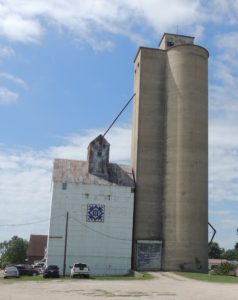Grain elevators, as we know them today, came into being in the mid to late 1920s after the U.S. Congress approved the “Capper Volstead Act” of 1922. That new law gave associations of grain producers some exemptions from the rigid anti-trust regulations of that time.
Of the grain elevators that were first constructed – almost all of them built with wood – most were eventually destroyed by fire or were otherwise replaced with newer construction.
The grain elevator in Jefferson that is located between the Greene County Fairgrounds and the Raccoon River Valley Trail is certainly historic, as it stands as a classic example of second- and third-generation grain elevator construction and operations.
This elevator is one of three grain facilities that were once operated by the company known as “Milligan Bros.” You can still see that name on a faded sign on the north side of the older building at the site. The other two Milligan Bros. facilities – located in the nearby towns of Cooper and Farlin – have long since been demolished.
Milligan Bros. was actually a successor company to the “D. Milligan Co.,” which was headquartered in Jefferson after being founded in 1905 by a partnership that included David Milligan. The company dealt in lumber, lime, cement, coal, grain and seed. As the commerce of agriculture grew, so did the company, and by the 1930s owned 14 grain elevators and lumberyards in western Iowa. The Great Depression, with “10-cent corn” and droughts in 1934 and 1936, was very hard on the company.
In 1942, it was divided, with the “E.A. Milligan and Son” moving to Des Moines. “Milligan Bros.,” owned by brothers Frank Jr. and Bob Milligan, maintained its headquarters in Jefferson. Bob Milligan was the father of John Milligan, a current resident of Jefferson who is city engineer here.
The general business office of Milligan Bros. was located downtown in the lumberyard building that is now the home of the custom furniture-making business “RVP 1875” and “History Boy Theatre Co.”
The Milligan Bros. facility adjacent to the fairgrounds is made up of two buildings, located on a property that is 136 feet wide and 240 feet long, fronting on East Lincoln Way on the east side of Jefferson. A small office building at the site was long ago removed.
The east building, often called “the Annex” in recent years, was built in 1935, with the sidewalls being 6-inch wide board planks, each of them 2 inches thick, stacked and fixed together, then covered by steel sheeting. Its dimensions are 30 feet wide, 40 feet long and 40 feet high. It has a capacity of 47,000 bushels of grain in 12 “cribbed” bins built inside of it. Those individual bins had capacities of from 5,000 to 7,000 bushels of grain.
The concrete silos were added on the west side of the facility in 1950. Dimensions of this building are 40 feet wide, 40 feet long and 110 feet high. It has a capacity of 80,000 bushels of grain in 13 bins inside of it.
In 1977, the Farmers Cooperative Association headquartered in Ralston, acquired Milligan Bros. Two years later, Farmers Cooperative also acquired the large cooperative in Boone and then became “West Central Cooperative.” On April 1, 2016, West Central Cooperative, which had been headquartered in Ralston, merged with Farmers Cooperative, headquartered in Ames, and became Landus Cooperative, with the new merged headquarters in Ames.
An intriguing part of the Milligan Bros. grain elevator story in Jefferson is that at the time the company was acquired in1977 by Farmers Cooperative Association/West Central Cooperative, the manager of the facility for several years had been Alma Shorey Young.
“She was one of the very few women ever to be the manager of a grain co-op,” said Larry Thomsen, of Jefferson, a former West Central Cooperative executive who knew her – and even was her competitor in the grain business for a time. “I remember that when the co-op managers from all over the country would have their big conventions, Alma would be the only woman there,” Thomsen said. “And let me tell you, she could hold her own in this business. She was a tough, tough person, and she knew her grain business extraordinarily.”

